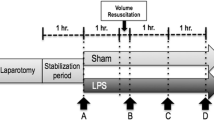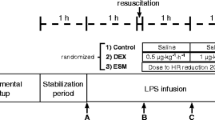Summary
The liver metabolic response of rats following a standardized intestinal shock, induced by applying a pressure of 120cm water on the mesenteric vessels for 60 min, was studied. Immediately prior to the release of the pressure on the vessels saline or naloxone was given either as a single injection or as a continuous infusion. After the reperfusion of the intestine no early disturbances in liver metabolism were found as evidenced from the ATP, glucose and lactate levels in liver biopsies taken 15 min following reflow. Within 60 min of reflow reduction of ATP and increases of glucose and lactate levels occurred. There were no major hemodynamic or liver metabolic differences between saline- and naloxone-treated shocked rats. When saline or naloxone was given as a continuous infusion, the changes in liver metabolism were, however, less severe than those observed in the single injection situation pointing toward a non-specific effect of volume replacement rather than a blockade of opioid receptors. Hepatic hypoxia and/or cellular effects of “shock factors” could be mechanisms of pathophysiologic importance for the disturbed liver metabolism in this shock model.
Similar content being viewed by others
References
Bessey PQ, Black PR, Colpoys MJ, Wilmore DW (1982) Barbiturate anesthesia suppresses insulin release. Surg Forum 33:23
Biedermann M (1968) Das Verhalten der Memdranpotentiale von Leberzellen der Ratte während und nach Gefäßunterbindungen. Acta Biol Med Germ 21:827–833, 1968
Blackwood JM, Hsieh J, Fewel J, Rush BF Jr (1973) Tissue metabolites in endotoxin and hemorrhagic shock. Arch Surg 107:181–185
Bulkley GB, Oshima A, Bailey RW (1986) Pathophysiology of hepatic ischemia in cardiogenic shock. Am J Surg 151:87–97
Chaudry IH, Sayeed MM, Baue AE (1972) Alterations in adenosine nucleotides in hemorrhagic shock. Surg Forum 23:1–3
Chiu CJ, McArdle AH, Brown R, Scott HJ, Gurd FN (1970) Intestinal mucosal lesion in low-flow states. A morphological, hemodynamic and metabolic reappraisal. Arch Surg 101:478–483
Diem KR, Lentner C (1979) Scientific tables. Ciba-Geigy, Basle
Faden AI, Holoday JW (1979) Opiate antagonists. A role in the treatment of hypovolemic shock. Science 205:317–318
Filkins JP, Cornell RP (1974) Depression of hepatic gluconeogenesis and the hypoglycemia of endotoxin shock. Am J Physiol 227:778–781
Filkins JP, Buchanan BJ, Cornell RP (1975) Hepatic carbohydrate metabolic alterations during endotoxic and traumatic shock. Circ Shock 2:129–135
Hagberg H, Haljamäe H, Johansson B, Pettersson B, Wennberg E (1983) Liver and skeletal muscle metabolism, extracellular K+ concentrations and survival in spontaneously hypertensive rats following acute blood loss. Circ Shock 10:61–70
Haglind E, Haglund U, Lundgren O, Romanus M, Scherstén T (1980) Graded intestinal vascular obstruction. I. Description of an experimental shock model in the rat. Circ Shock 7:83–91
Haglind E, Haglund U, Lundgren O, Scherstén T (1981) Graded intestinal vascular obstruction. III. An analysis of pathogenic mechanisms. Circ Shock 8:335–341
Haglind E (1981) Intestinal vascular obstruction. Pathophysiological mechanisms in a shock model. Thesis, Faculty of Medicine, University of Göteborg, Göteborg, Sweden.
Haglind E, Haglund U, Lundgren O, Scherstén T (1986) Effects of naloxone in intestinal shock in the rat. Circ Shock 19:309–318
Haglund U, Hultén L, Åhrén C, Lundgren O (1975) Mucosal lesions in the human small intestine in shock. Gut 16:979–984
Haglund U, Abe T, Åhrén C, Braide I, Lundgren O (1976) The intestinal mucosal lesions in shock. I. Studies on pathogenesis. Eur Surg Res 8:435–477
Heydorn WH, Moores WY, Bellamy RF, O'Benar JD (1985) Naloxone: Ineffective in improving cardiac performance after hypoperfusion in swine. Circ Shock 17:35–43
Holaday JW, Faden AI (1978) Naloxone reversal of endotoxin hypotension suggests role of endorphins in shock. Nature 275:450–451
Holaday JW, D'Amato RJ, Ruvio BA, Feuerstein G, Faden AI (1983) Adrenalectomy blocks pressor responses to naloxone in endotoxic shock: Evidence for sympathomedullary involvement. Circ Shock 11:201–210
Jennische E, Enger E, Medegård A, Appelgren L, Haljamäe H (1978) Correlation between tissue pH, cellular transmembrane potentials and cellular energy metabolism during shock and during ischemia. Circ Shock 5:251–260
Jennische E, Medegård A, Haljamäe H (1978) Transmembrane potential changes as an indicator of cellular metabolic deterioration in skeletal muscle during shock. Eur J Surg Res 10:125–133
Jennische E (1981) Immediate effects of hemorrhage on the hepatic cell membrane potential in the rat. Acta Physiol Scand 112:343–344
Lambotte L (1977) Effect of anoxia and ATP depletion on the membrane potentiale and permeability of dog liver. J Physiol (Lond) 269:53–76
Lowry OH, Rosebrough HJ, Fare A, Randall RJ (1951) Protein measurement with the folin phenol reagent. J Biol Chem 193:265–275
Lowry OH, Passoneau JV (1972) In a flexible system of enzymatic analysis. Academic Press, New York
Lechner RB, Gurll NJ, Reynolds DG (1985) Role of the autonomic nervous system in mediating the response to naloxone in canine hemorrhagic shock. Circ Shock 16:279–295
van der Meer C, Valkenburg PW, Versluys-Broers JAM (1981) Disturbances in the glucose metabolism in intestinal ischemia shock. Circ Shock 8:375–392
Patton ML, Gurll NJ, Reynolds DG, Vargish T (1983) Adrenalectomy abolishes and cortisol restores naloxone's beneficial effects on cardiovascular function and survival in canine hemorrhagic shock. Circ Shock 10:317–327
Reynolds DG, Gurll NJ, Vargish T, Lechner RB, Faden AI, Holaday JW (1980) Blockade of opiate receptors with naloxone improves survival and cardiac performance in canine endotoxic shock. Circ Shock 7:39–48
Sayeed MM, Adler RJ, Chaudry IH, Baue AE (1981) Effects of hemorrhagic shock on transmembrane potentials and intracellular electrolytes in vivo. Am J Physiol 240:R211–219
Wennberg E, Hagberg H, Haljamäe H, Johansson B (1983) Effects of hemorrhagic hypotension on brain and liver metabolism in normotensive (WKY) and spontaneously hypertensive rats (SHR). Hypertension 1:221–226
Wood CD, Bentz Y, Mullaney C, Daniel AM (1975) Carbohydrate metabolism and the hemodynamic response to shock. J Surg Res 38:1–6
Author information
Authors and Affiliations
Additional information
Supported by grants from the Swedish Medical Research Council (project nos. 07939, 4502, 05416); Tore Nilson Foundation for Medical Research; Albert Nilssons Foundation; Swedish Medical Society; The Medical Research Council of the Swedish Life Insurance Companies.
Rights and permissions
About this article
Cite this article
Haglind, E., Haglund, U. & Haljamäe, H. Liver metabolic effects of intestinal shock and naloxone treatment in the rat. Res. Exp. Med. 188, 197–207 (1988). https://doi.org/10.1007/BF01852321
Received:
Accepted:
Issue Date:
DOI: https://doi.org/10.1007/BF01852321




